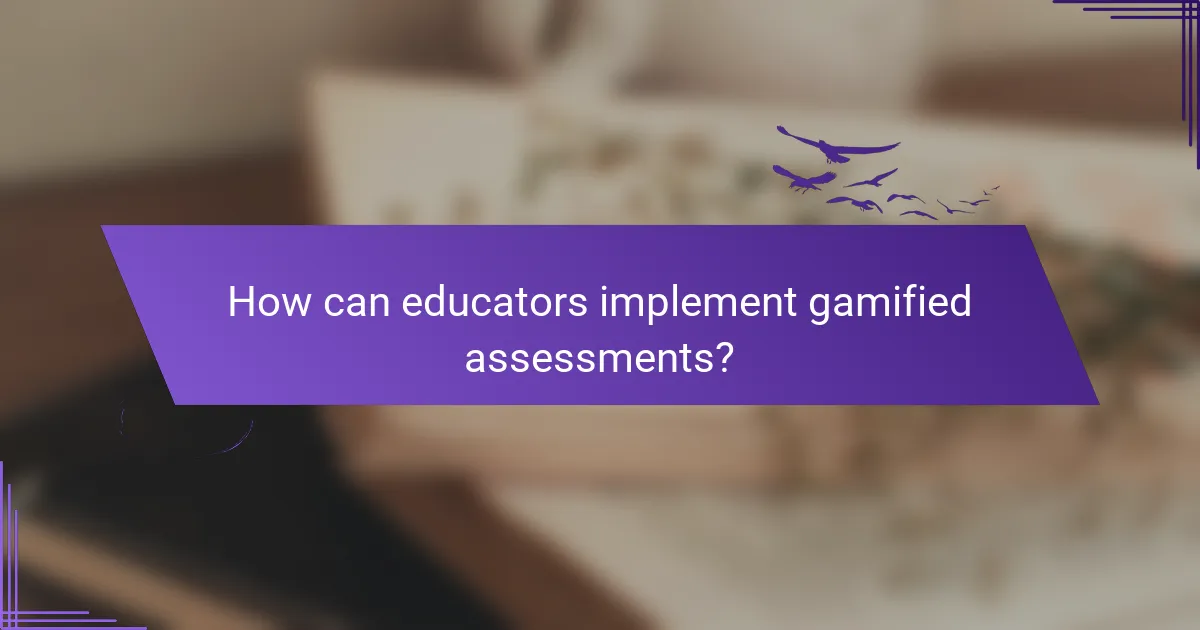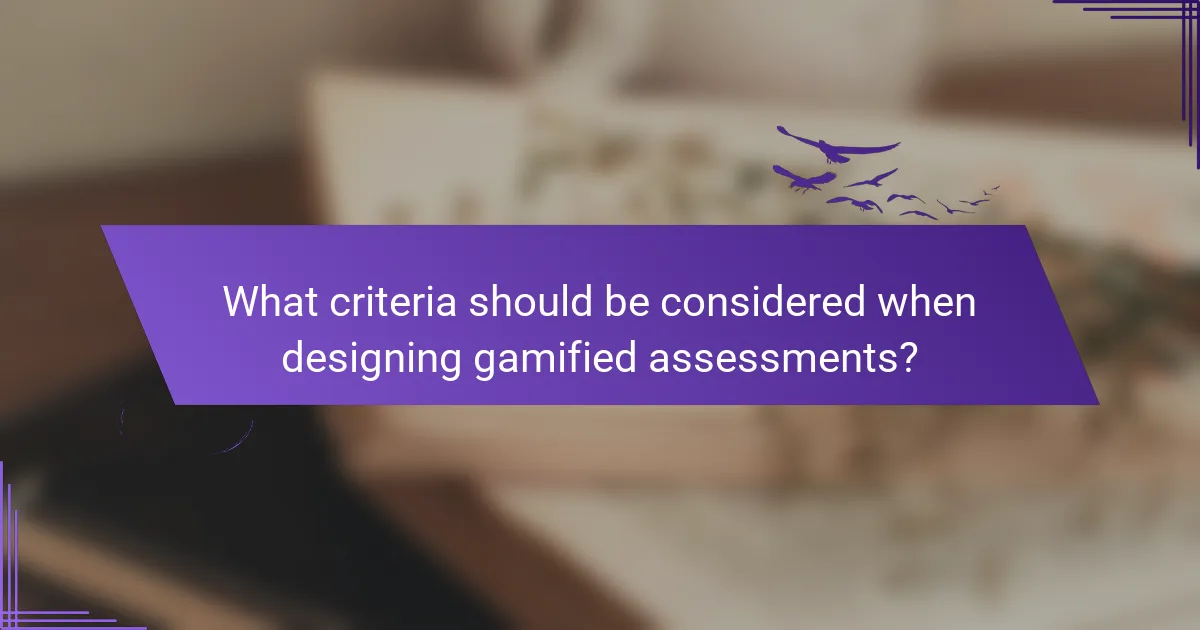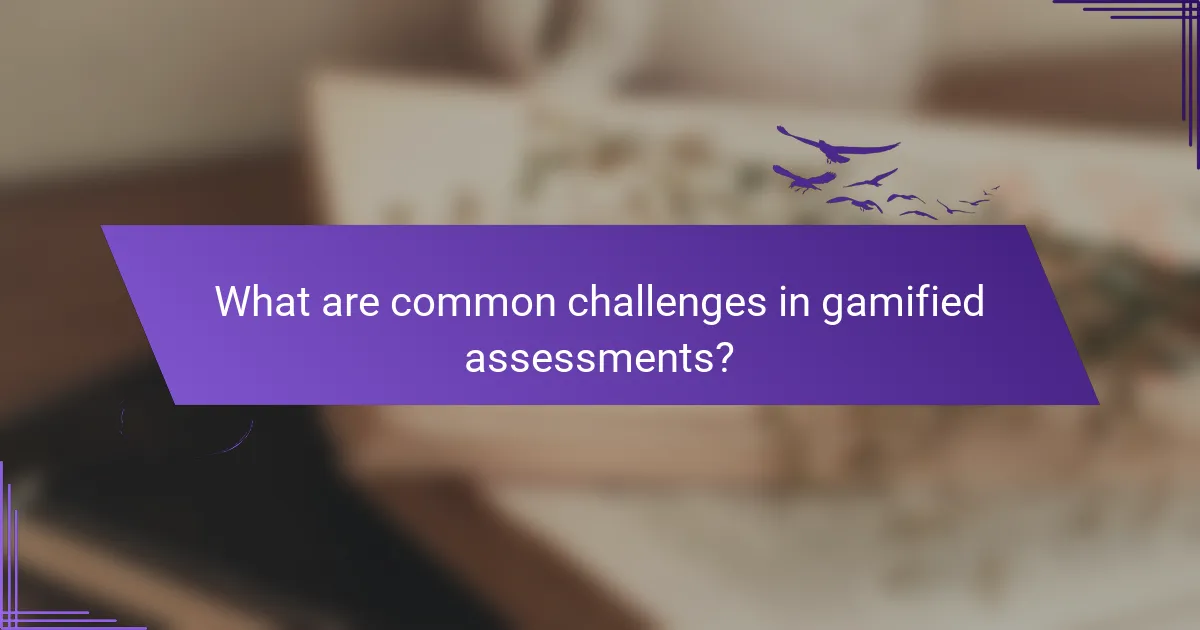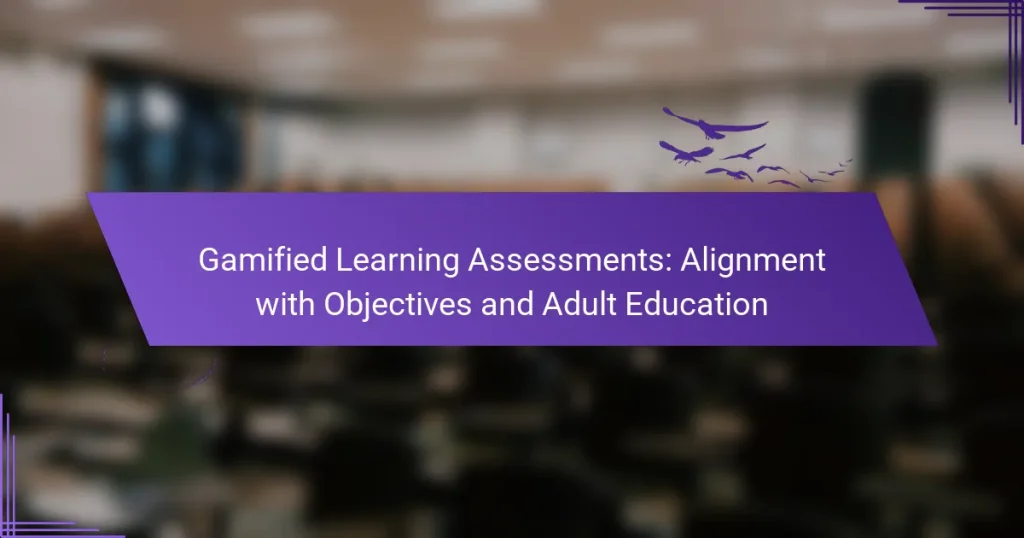Gamified learning assessments play a crucial role in adult education by boosting motivation and engagement, while also supporting skill acquisition. By incorporating game-like elements, these assessments create a more relevant and enjoyable learning experience, effectively aligning with educational objectives.

How do gamified learning assessments align with adult education objectives?
Gamified learning assessments effectively align with adult education objectives by enhancing motivation and engagement while facilitating skill acquisition. These assessments integrate game-like elements that resonate with adult learners, making the educational experience more relevant and enjoyable.
Enhanced engagement through interactive elements
Interactive elements in gamified assessments, such as quizzes, simulations, and challenges, capture learners’ attention and encourage active participation. Adults often have busy schedules, so incorporating these engaging features can make learning feel less like a chore and more like a rewarding experience.
For example, a training program for corporate employees might include a leaderboard to foster competition, motivating participants to improve their scores. This not only increases engagement but also promotes a sense of community among learners.
Improved retention via game mechanics
Game mechanics, such as rewards, levels, and feedback loops, significantly enhance knowledge retention in adult learners. By providing immediate feedback and rewards for achievements, these assessments reinforce learning and help solidify concepts in long-term memory.
Consider a scenario where learners earn points for completing modules or can unlock new content by mastering previous sections. This structure encourages continuous learning and helps adults retain information more effectively than traditional assessment methods.

What are effective gamified assessment strategies for online courses?
Effective gamified assessment strategies for online courses engage learners through interactive elements while aligning with educational objectives. These strategies not only enhance motivation but also provide meaningful feedback on learners’ progress.
Scenario-based assessments
Scenario-based assessments immerse learners in realistic situations that require critical thinking and problem-solving. By simulating real-world challenges, these assessments help learners apply theoretical knowledge in practical contexts, enhancing retention and understanding.
When designing scenario-based assessments, consider the relevance of the scenarios to the learners’ field. For example, a business course might include a case study where learners must make strategic decisions based on market data. Ensure that scenarios are complex enough to challenge learners but not so difficult that they become discouraging.
Point systems and rewards
Point systems and rewards motivate learners by providing tangible recognition for their efforts and achievements. By assigning points for completing tasks, participating in discussions, or achieving high scores on assessments, learners can track their progress and feel a sense of accomplishment.
To implement an effective point system, establish clear criteria for earning points and communicate these to learners. Consider offering rewards such as badges, certificates, or access to exclusive content. This approach not only fosters competition but also encourages collaboration among peers, enhancing the overall learning experience.

How can educators implement gamified assessments?
Educators can implement gamified assessments by integrating interactive elements that engage learners while measuring their understanding of course material. This approach not only enhances motivation but also aligns assessments with educational objectives, making learning more enjoyable and effective.
Utilizing platforms like Kahoot!
Kahoot! is a popular platform that allows educators to create interactive quizzes and games. By designing quizzes that align with learning objectives, teachers can foster a competitive yet collaborative environment where students can participate in real-time. This platform is particularly effective for formative assessments, as it provides immediate feedback to both educators and learners.
To maximize the effectiveness of Kahoot!, consider incorporating a mix of question types, such as multiple-choice and true/false, to cater to different learning styles. Additionally, setting a time limit for each question can increase engagement and urgency, making the assessment feel more game-like.
Incorporating quizzes in Moodle
Moodle offers a robust framework for creating quizzes that can be gamified through various settings and plugins. Educators can utilize features like adaptive learning paths and gamification plugins to create a more dynamic assessment experience that aligns with course objectives. This flexibility allows for personalized learning experiences tailored to individual student needs.
When using Moodle, it’s essential to clearly define the learning outcomes for each quiz and ensure that the questions are directly related to these objectives. Regularly updating the quiz content and incorporating elements like badges or leaderboards can further motivate learners and enhance their engagement with the material.

What are the benefits of gamified assessments in adult learning?
Gamified assessments enhance adult learning by increasing engagement and aligning educational objectives with interactive experiences. These assessments transform traditional evaluation methods into dynamic activities that motivate learners and provide valuable insights into their progress.
Increased motivation and participation
Gamified assessments significantly boost motivation and participation among adult learners. By incorporating game-like elements such as points, badges, and leaderboards, these assessments create a competitive yet enjoyable environment that encourages learners to engage actively with the material.
For instance, a training program might reward participants with points for completing modules or achieving specific milestones. This not only fosters a sense of accomplishment but also drives learners to invest more time and effort into their education.
Immediate feedback and performance tracking
One of the key advantages of gamified assessments is the provision of immediate feedback, which is crucial for adult learners. Instant feedback allows learners to understand their strengths and weaknesses in real-time, enabling them to adjust their strategies and improve their performance without delay.
Additionally, gamified systems often include performance tracking features that allow learners to monitor their progress over time. This can be achieved through visual dashboards that display scores, completed tasks, and areas needing improvement, making it easier for learners to stay on track and motivated.

What criteria should be considered when designing gamified assessments?
When designing gamified assessments, it is essential to ensure they align with educational objectives, engage learners effectively, and accommodate various learning preferences. Key criteria include clarity of learning outcomes, inclusivity for diverse learning styles, and the integration of meaningful feedback mechanisms.
Alignment with learning outcomes
Gamified assessments must directly align with the intended learning outcomes to be effective. This means that each game element should reinforce the skills or knowledge that learners are expected to acquire. For example, if the objective is to enhance critical thinking, the assessment could include problem-solving scenarios that require analysis and decision-making.
Additionally, clear mapping of game mechanics to learning objectives helps in evaluating whether the assessment is achieving its goals. Consider using a rubric that connects specific game tasks to the desired outcomes, ensuring that learners understand how their performance translates to real-world skills.
Inclusivity for diverse learning styles
To cater to a wide range of learning styles, gamified assessments should incorporate various formats and approaches. For instance, visual learners might benefit from infographics or videos, while auditory learners may prefer interactive storytelling or discussions. Providing multiple ways to engage with content can enhance the learning experience for all participants.
Moreover, consider offering choices within the assessment. Allowing learners to select from different tasks or challenges can empower them and increase motivation. This flexibility can help accommodate individual preferences and promote a more inclusive learning environment.

What are common challenges in gamified assessments?
Gamified assessments often face challenges such as maintaining a balance between engagement and educational effectiveness, as well as ensuring technology accessibility for all learners. These issues can hinder the overall success of gamified learning experiences.
Balancing fun and educational value
Creating a gamified assessment that is both enjoyable and educational can be difficult. While engaging elements like rewards and competition can motivate learners, they must not overshadow the learning objectives. Striking the right balance involves integrating educational content seamlessly into the game mechanics, ensuring that fun activities reinforce key concepts rather than distract from them.
To achieve this balance, educators should focus on clear learning outcomes and align game elements with these goals. For instance, using quizzes or challenges that require applying knowledge can enhance both engagement and retention. Regular feedback can also help learners understand their progress and areas for improvement.
Technology accessibility issues
Technology accessibility is a significant challenge in implementing gamified assessments, especially in diverse educational settings. Not all learners may have access to the necessary devices or high-speed internet, which can create disparities in participation and performance. Ensuring that all students can engage with gamified assessments requires careful planning and resource allocation.
To address accessibility issues, educators should consider using platforms that are compatible with various devices, including smartphones and tablets. Additionally, offering offline options or simplified versions of the assessments can help accommodate learners with limited technology access. Regularly assessing the technological needs of the student population can also inform necessary adjustments and support.

How do gamified assessments compare to traditional assessments?
Gamified assessments often outperform traditional assessments by enhancing learner engagement and motivation. While traditional methods focus on rote memorization and standardized testing, gamified approaches incorporate game elements that make learning more interactive and enjoyable.
Higher engagement rates
Gamified assessments significantly boost engagement rates compared to traditional assessments. By integrating elements like points, badges, and leaderboards, learners are more likely to participate actively and invest time in their learning. This interactive format caters to adult learners who often seek meaningful and relevant experiences.
For example, a study might show that learners using gamified assessments spend 30-50% more time on tasks than those using conventional methods. This increased engagement can lead to better retention of information and improved performance on subsequent assessments.
To maximize engagement, consider incorporating challenges that align with learners’ interests and goals. Avoid overly complex game mechanics that could distract from the learning objectives. Instead, focus on clear rewards and feedback that motivate learners to progress.


